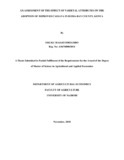| dc.description.abstract | Improved cassava varieties are vital for ensuring food security in the rural households in the face of the changing climatic conditions, which have resulted to poor performance of the common staple food crops. In view of this, new cassava varieties such as TMS 30572 TM14, MH93/OVA and yellow cassava have been released and adoption is rated at 25 per cent in Homa-Bay County. However, there is little empirical insight on farmers’ awareness and the effect of varietal attributes on the uptake of these varieties. While several previous studies have analysed adoption drivers of improved varieties, none has determined the influence of varietal attributes on the uptake of the improved varieties. The overall objective of this study was to assess farmers’ awareness and the effect of varietal attributes on the adoption of improved varieties. The specific objectives were to: characterize farmers’ awareness, perception and adoption of improved cassava varieties; determine the effect of varietal attributes on the adoption of the improved cassava varieties; and assess the influence of varietal attributes on the intensity of adoption of these varieties. A multi-stage sampling method was used to randomly select some 129 cassava farmers as respondents for the study. The study used both primary and secondary data. A semi-structured questionnaire was used to collect primary data from the respondents. The study used multivariate probit and Poisson regression models to analyse the determinants of adoption decision and the intensity of adoption, respectively.
The study found that six cassava varieties were grown in the study area, four of which were improved varieties, TMS 30572, TM/14, MH93/OVA and yellow cassava, while the rest were local varieties, Selele and Obaro Dak. Farmers were generally aware of the existence of these varieties. Results showed that 29.4 per cent, 25.7 per cent, 16.5 per cent and 14.3 per cent of farmers adopted TMS 30572, TM/14, MH93/OVA and yellow cassava, respectively while 38 per cent and 34 per cent still maintained Selele and Obaro Dak. Notably, the adoption of one cassava variety did not preclude the adoption of other varieties. The results revealed that improved
xi
cassava varieties were perceived to have desirable production attributes such as yield, early maturity, drought tolerance, and resistance to pests and diseases, whereas local varieties were grown due to their tastes and resistance to drought.
Likewise, the multivariate probit results demonstrated that the perceived desirable characteristics of yield, early maturity, resistance to pests and diseases and tolerance to drought positively influenced the adoption of the improved varieties, while their relatively blunt taste and lengthy cooking time reduced the adoption. Among the socioeconomic factors, household size, land size, access to extension services and group membership increased the likelihood of adopting these improved varieties. On the contrary, age of the household head had a negative effect on the probability of adopting MH93/OVA. The results of the Poisson model also revealed that the perceived yield potential and early maturity positively affected the degree of adoption of the improved cassava varieties, while the perceived dull taste and longer cooking time had negative effects on the same. Age of the household head also negatively influenced the degree of adoption, whereas household size, land size, level of education, access to extension services and group membership positively affected the extent of adoption of the improved varieties. Based on these findings, the study recommends that cassava breeders should not only focus on enhancing production attributes, but also consumption attributes so as to address farmers’ different needs in adoption. Moreover, it is deemed appropriate that producers, processors and consumers should be involved in the evaluation process of the new cassava varieties so as to ensure acceptance by the end users.
Keywords: Improved Cassava Varieties; Varietal Attributes; Awareness; Adoption; Kenya. | en_US |



